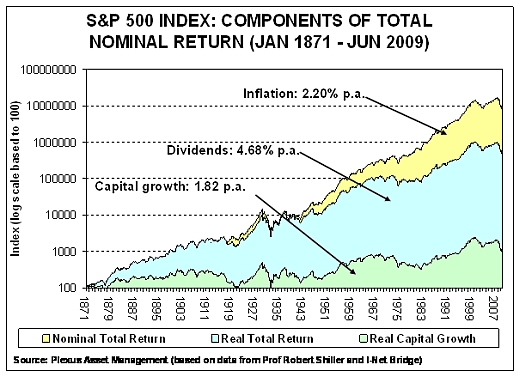Consider the Components of Long-term Stock Market Returns
Stock-Markets / Stock Market Valuations Jun 30, 2009 - 05:23 AM GMT The raison d’être of investment or wealth management is to maintain, or hopefully improve, one’s standard of living, i.e. to earn a real return on the investment amount. This sounds easy enough if one considers that the S&P 500 Index (and its predecessors prior to 1957) delivered a nominal return of 8.7% per annum from January 1871 to June 2008. With an average inflation rate of 2.2% per annum over the period, this meant a real return of 6.5% per annum.
The raison d’être of investment or wealth management is to maintain, or hopefully improve, one’s standard of living, i.e. to earn a real return on the investment amount. This sounds easy enough if one considers that the S&P 500 Index (and its predecessors prior to 1957) delivered a nominal return of 8.7% per annum from January 1871 to June 2008. With an average inflation rate of 2.2% per annum over the period, this meant a real return of 6.5% per annum.
Yes, I can hear many readers arguing that much better returns can be generated by “playing” the market cycles, especially given the fact that the S&P 500 has made no headway since 1998. Ah, the art of market timing! Perhaps, but keep in mind that very few people have succeeded in consistently outperforming the market over any extended period of time, especially once costs and taxes are factored in.
Let’s go back to the total nominal return of 8.7% per annum and analyze its components. We already know that 2.2% per annum came from inflation. Real capital growth (i.e. price movements net of inflation) added another 1.8% per annum. Where did the rest of the return come from? Wait for it, dividends - yes, boring dividends, slavishly reinvested year after year, contributed 4.7% per annum. This represents more than half the total return over time!
Have a look at the following chart:

The numbers are summarized below in table format.

Source: Plexus Asset Management (based on data from Prof Robert Shiller and I-Net Bridge)
In an environment characterized by increasingly shorter investment horizons, the concept of compounding sounds so passé, but it remains one of the most important principles governing investment. The time has perhaps come to look beyond the short-term noise and focus on good old stock picking, and specifically those companies with strong balance sheets that will be growing their dividends over time with a reasonable degree of certainty. After all, compound growth has not without reason been referred to as the eighth wonder of the world.
By Dr Prieur du Plessis
Dr Prieur du Plessis is an investment professional with 25 years' experience in investment research and portfolio management.
More than 1200 of his articles on investment-related topics have been published in various regular newspaper, journal and Internet columns (including his blog, Investment Postcards from Cape Town : www.investmentpostcards.com ). He has also published a book, Financial Basics: Investment.
Prieur is chairman and principal shareholder of South African-based Plexus Asset Management , which he founded in 1995. The group conducts investment management, investment consulting, private equity and real estate activities in South Africa and other African countries.
Plexus is the South African partner of John Mauldin , Dallas-based author of the popular Thoughts from the Frontline newsletter, and also has an exclusive licensing agreement with California-based Research Affiliates for managing and distributing its enhanced Fundamental Index™ methodology in the Pan-African area.
Prieur is 53 years old and live with his wife, television producer and presenter Isabel Verwey, and two children in Cape Town , South Africa . His leisure activities include long-distance running, traveling, reading and motor-cycling.
Copyright © 2009 by Prieur du Plessis - All rights reserved.
Disclaimer: The above is a matter of opinion and is not intended as investment advice. Information and analysis above are derived from sources and utilizing methods believed reliable, but we cannot accept responsibility for any trading losses you may incur as a result of this analysis. Do your own due diligence.
Prieur du Plessis Archive |
© 2005-2022 http://www.MarketOracle.co.uk - The Market Oracle is a FREE Daily Financial Markets Analysis & Forecasting online publication.



